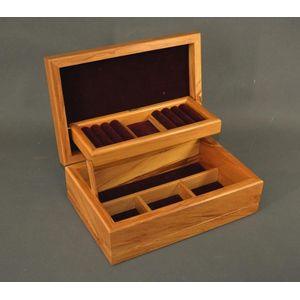Antique Lacemakers Collectors Cabinet
You must be a subscriber, and be logged in to view price and dealer details.
Subscribe Now to view actual auction price for this item
When you subscribe, you have the option of setting the currency in which to display prices to $Au, $US, $NZ or Stg.
- Ivory - Ivory is a hard white material that comes from the tusks of elephants, mammoth, walrus and boar, or from the teeth of hippopotamus and whales. The ivory from the African elephant is the most prized source of ivory. Although the mammoth is extinct, tusks are still being unearthed in Russia and offered for sale.
Ivory has been used since the earliest times as a material for sculpture of small items, both in Europe and the east, principally China and Japan.
In Asia ivory has been carved for netsuke, seals, okimono, card cases, fan supports, animals and other figures and even as carved tusks.
In the last 200 years in Europe ivory has been used to carve figures, for elaborate tankards, snuff boxes, cane handles, embroidery and sewing accessories, in jewellery and as inlay on furniture. Its more practical uses include being used for billiard balls, buttons, and a veneers on the top of piano keys.
The use and trade of elephant ivory have become controversial because they have contributed to Due to the decline in elephant populations because of the trade in ivory, the Asian elephant was placed on Appendix One of the Convention on International Trade in Endangered Species (CITES), in 1975, and in January 1990, the African elephant was similarly listed. Under Appendix One, international trade in Asian or African elephant ivory between member countries is forbidden. Unlike trade in elephant tusks, trade in mammoth tusks is legal.
Since the invention of plastics, there have been many attempts to create an artificial ivory
This item has been included into following indexes:
Visually similar items

Sixty eight pieces of antique silver flatware, made in London with various dates between 1837 & 1863, plus 12 of each modern table knives to match (dates stated in certificate in photos), in a three drawer fitted walnut canteen, weight 4.39 kilograms not i

A twelve place silver plate cutlery canteen with ivorine handles, Harrison Bros & Howson. In a fitted mahogany case. One carving fork missing, circa 1930.

A traveling cash drawer, interior fitted and labelled for pre-decimal currency, circa 1900 A travelling cash drawer, interior fitted and labelled for pre-decimal currency, circa 1900 15 cm high, 34 cm wide, 30 cm deep

New Zealand wood jewellery box. Felt lined, with divisions for rings etc. On two levels. Length 29 cm. Diameter 19 cm. Height 11 cm
